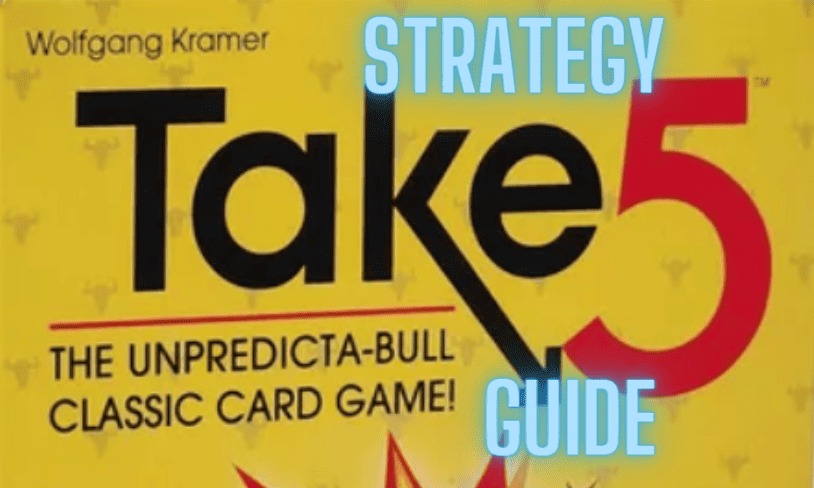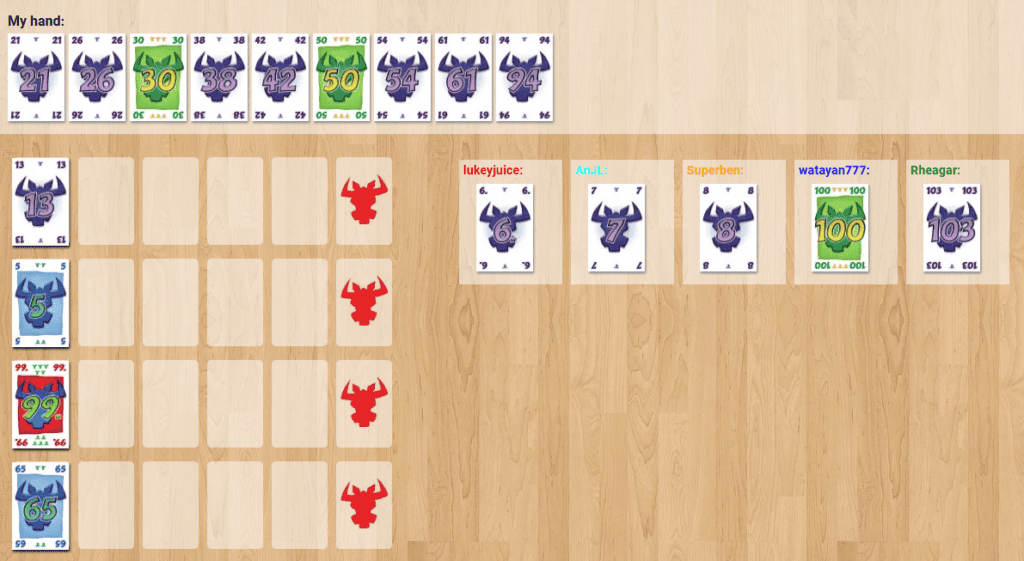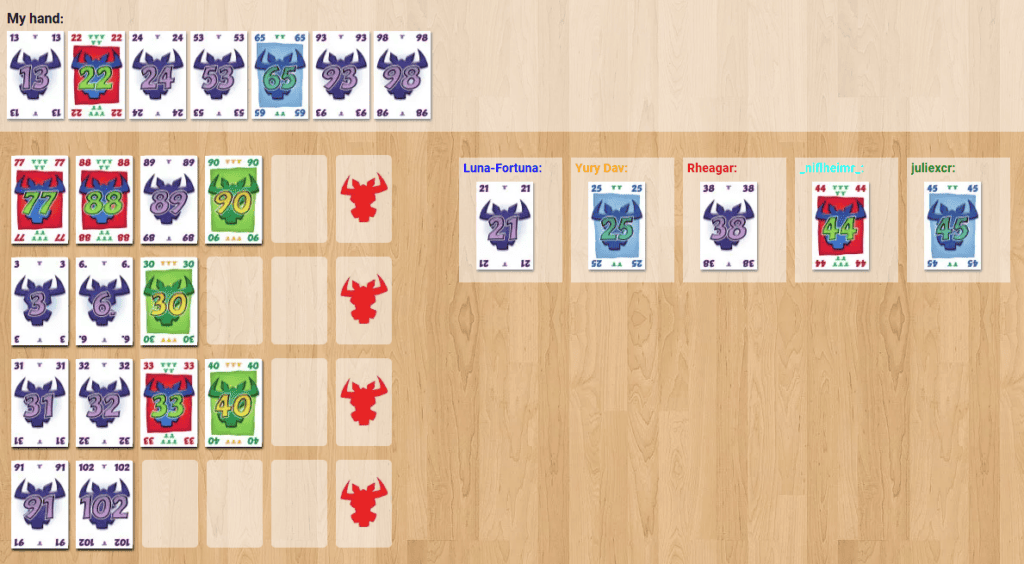
Take 5 (also known as 6 Nimmt!) is a relatively simple card game that packs a surprising amount of strategy and forward thinking. My family and I recently picked this game up and it has become one of our go-to games while on vacation, so naturally I learned everything I could about how to mercilessly win every time! These tips and strategies will help you to improve at Take 5 (or 6 Nimmt!) and win more often.
In general, the best Take 5 strategies are to control the game with your first cards, get rid of bad cards by taking low-point rows, and predict where opponents will play. You should also try to slightly undercut the highest cards when rows are nearly full, and track the cards that have been played.
These tips specifically apply to the normal version of Take 5, but most of them can also be used for the ‘Tactic’ and ‘Professional’ variations. Every game of Take 5 (or 6 Nimmt!) plays out differently, but knowing how and why these strategies work will help you implement them in your own games to come out on top more often.
Play outlier cards on your first turns
It is fairly rare for a player to have to take a row of 5 cards on the first turn. In fact, if you’re playing with 4 or fewer players it’s impossible to do so. Therefore, the first and, to a lesser extent, the second rounds of the game are the ‘safest’ time to play cards that would clearly become problematic in the future.

You should always give heavy consideration to playing extremely low cards (1-10) on the first turn. These cards are virtually guaranteed to take a row eventually, so it’s best to do it while there are fewer cards (and bulls) on the table.
You may also consider playing extremely high cards (100-104) which will virtually ‘lock’ a row from growing on subsequent turns. This limits the options other players have and can be to your advantage if you want players to continue building on the other three rows.
Use small cards to take low-point rows
Small cards are usually the most problematic cards in the game because there are very few times when you’ll have the opportunity to add them to the end of a row. Therefore, whenever you get the opportunity to take a row worth only 1 or 2 bulls with one of your low cards you should probably take it.
Playing lower cards earlier in the game leads to more victories.
-The Effect of Different Strategies on Winning 6 Nimmt
In this statistical study of 6 Nimmt!, the researchers concluded that “playing lower cards earlier in the game leads to more victories.” This is a conclusion that I have come to myself after many play-throughs, and the reason is a simple matter of risk mitigation. By purposely taking a low-point row with a low card, you are ensuring that you aren’t forced to take a very costly row later in the game.
Remember cards that have been played
There are 104 cards in Take 5 (or 6 Nimmt!), making card counting a challenging but reasonably attainable strategy. Top players have played enough to do this with relatively little effort, but for more casual players this probably isn’t feasible.
CHECK IT OUT: Do you struggle to hold all of the cards in your hand? So did my daughter, until we got her these handy curved wooden card holders from Amazon to make things more manageable for her.
Instead of tracking every card that has been played, simply try to keep track of the extremely high and low cards. Try to remember if 1-10 and 95-104 have been played so that you’ll know what cards remain on each end of the spectrum. This is extremely useful at the end of a round when players’ options become more limited and they’re forced to play cards they may not otherwise want to.
When in doubt, play the card worth more bulls
There are usually several (or many!) times in a round of Take 5 when you’re just not sure what to play. Sometimes you’ll have two or three cards that seem like viable options but you can’t make up your mind because there are just too many variables at play.
In these cases, I like to play the card that is worth the most bulls. This is just a rule of thumb, but it works as a good tie-breaker between cards I’m considering. By playing the card worth the most bulls, you force your opponents to take the risk of taking that card on that turn. This is especially useful when all of the rows are nearly full. Remember, even if you complete a row with your card you won’t take the points from it – just the rest of the row you complete.
Get rid of bad cards by taking a few points
It’s almost inevitable that you’ll end up with some bad cards you can’t seem to get rid of. If and when this happens to you, look for opportunities to minimize the damage they do to your score.

We already talked about the most common scenario in which this happens, which is taking low-point rows with very low cards. However, you might also consider risking taking a row full of 1-bull cards to get rid of a very high card (100-104). Sometimes this can be a tough pill to swallow, but if it saves you from taking a row worth a ton of points later on you’ll be thanking yourself.
Slightly undercut when all rows are almost full
There almost always comes a point in a round when all of the rows are almost full and the highest card is fairly high (~70 or higher). This is typically a precarious situation and at least one player will usually end up taking a row.
I have found that the best strategy in these situations is to play your highest card that is still lower than the lowest high card in a row. This usually doesn’t absolutely guarantee that you won’t take points on that turn, but it has an extremely high success rate.

For example, in the situation above I (Rheagar) chose to play the ’54’. This is my highest card and, importantly, it’s lower than the 61 which is the lowest high card in any row. This means that the only way I’ll end up taking points on this round is if my ’54’ is the lowest card any player chose to play on this round.
Play slightly higher than a row’s highest card
Alternatively, you can play a card that is just slightly higher than the highest card in a particular row. How near the card has to be for complete safety depends on the number of slots left on that row and how many players are in the game.

For example, in the situation above the player ‘Yury Dav’ chose to play his ’15’, targeting the second row. The only way he would take that row is if two other players played ’13 and ’14’, respectively. This is extremely unlikely, or maybe even impossible if either of those cards has already been played. Knowing this, he decided that he can safely play the ’15’.
Think about where opponents are likely to play
Take 5 is largely about probabilities and risk mitigation, but the best players seem to have a 6th sense about what cards their opponents will try to play. This intuition comes with experience and lots of play-throughs, and can be especially powerful if you play the same people over and over again. For example, I play with my wife all the time so I know that she has a very conservative play style.
Most players have a tendency to focus their attention on rows with more open spaces. This is only natural, because it feels like that row is further away from forcing anyone to take points. However, if everyone does this then there is often a higher risk of cards being piled into that row and someone taking points anyway.
You can use this tendency to your advantage by playing on a row that seems counter-intuitive or risky. It is far less likely that a lot of players will focus on rows closer to completion, so if you have a card that could reasonably be played there you should definitely take it under consideration.
Take rows based on the game situation, not points
Most players, especially new ones, automatically choose the row worth the fewest points when they’re forced to take a row. This is usually the best course of action and it certainly requires the least amount of thought, especially early in the game. However, sometimes taking a row worth more bulls is the better choice.
There are three scenarios where you might want to consider taking a row worth more points:
- You can force the current leading player to take more points
- To protect a player from losing points and ending the game when you’re not winning
- To force a losing player to lose points and end the game while you are leading
Each of these cases can be a complete game changer and have the potential to force a win or steal one away from another player. It only requires a little vision to see what effects your row choice will have, so take the time to calculate things before making your decision.
Play runs of cards based on the game variant
Having a run of 3 or more consecutive cards can be very powerful if used correctly (and with a little luck). You’ll want to handle runs like this a little differently depending on the variant of the game you’re playing.
In the normal (or standard) version of the game, it’s usually best to play the lowest card in the run first. This way, if that card is still the highest in the row on the next turn you’ll be able to play the next card in the sequence, and so on.
In the ‘professional’ variant of the game, things are a little different because cards can be placed on either side of the row. You should play the middle card first so that whether your card ends up on the front or the end of a row you’ll have an adjacent card to play next to it on the next turn.
Avoid targeting rows worth lots of points

Take 5 (or 6 Nimmt!) is mostly a game about risk mitigation. Some cards in the deck are worth a lot more bulls than others and you should do everything in your power to avoid taking them as part of a row.
To that end, you should avoid planning to play a card in a row with a lot of bulls unless you’re absolutely sure you have no chance of taking the row with that card. It’s better to play a card that has a slightly higher risk of taking a low-point row than it is to tolerate any risk of taking a high-point row.
Don’t rely on low-point rows to stay on the table
A common trap that many players (myself included) fall into is relying on a specific row to be available when their card is played. However, no matter how clever or correct-looking your card choice is, there is always a risk that the row you planned on will be taken by a player who chose (or was forced) to play a low card.
Try to avoid becoming overly reliant on one specific row being available when your card is played. This is especially true of rows that are worth very few bulls, since other players may decide to take them as part of their larger strategy. Always consider what would happen if the row you were planning on disappeared and then make adjustments if need be.
Thanks for reading! If I missed something or you have your own opinions, please drop a comment below.
What is thr benefit of along out first in hand? Seems to me like you would never want to assume…
Your strategy comments are excellent, well thought out and very helpful! Thank you
You would only get to draw and play a Sanctuary card on turn two of round one if the Region…
Rule question. If in phase one of round one I play a Region card with a Clue symbol at the…

Leave a Reply